Taita Speedway. (sometimes called Hutt Speedway) 1947 to 1956
This speedway was opened in the Hutt Valley, just north of the New Zealand capital, Wellington, on Boxing day 1947.
We are indebted to Jenny Floyd of New Plymouth, who donated two scrapbooks she kept during the early years while she was a member of the Taita Speedway Supporters Club. Much of the information is from newspaper clippings, so is presented in that format. Her records start in February 1948 and end in 1951.
Subsequently, we have been fortunate to be given or lent much more info from Taita and other early tracks in the lower North Island. We have also interviewed some of the early riders such as Kevin Hayden and will feature them later. Info has also kindly been given by Allan Batt of Christchurch.

This very early photo of Taita is before lights were erected and note that stoney surface!
Four records were broken at Taita Speedway on Saturday night. (newspaper article)
Bruce Abernethy, who celebrated the occasion by taking his first spill in public at the Taita track, bettered by one second the previous best one lap time and broke two other records and the crowd broke the attendance record. In a heat of the Big Nine scratch competition he took 1 and 1-5sec. off the one mile rolling start record. It was a good night for Abernethy who again beat Bill Bowe in the final of the Big Nine and was the most successful rider as Darkie Hansard who won two handicap events by sheer brilliancy of riding. Hansard might have been fortunate to get away with the final of the Taita Handicap.
In the third heat he had a great tussle with Bung McMillan who had beaten him in what appeared to have been a dead-heat. McMillan broke his chain just before the final and could not start. This leaving Hansard with a slightly easier task.
Les Moore, an Australian rider, had little luck. He did earn the applause of the crowd on one occasion though by deliberately going into a skid and throwing his machine down to avoid colliding with Bob Ford who had taken a dive. Making his first appearance at the Taita track was Rex Lane, but he experienced a lot of motor trouble and did not feature as prominently as he will.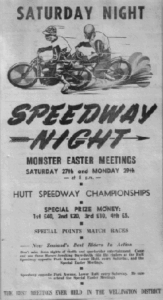
The final race on the programme saw Bowe, Boyle and Abernethy in the Big Nine event. Bowe was first away but Abernethy had taken the lead before the back straight and though he was challenged strongly went on to win narrowly.
Meetings between Boxing day and the above meeting were apparently of similar interest and attracted big crowds to watch the riders who were mostly new to this sport, gain rapidly in skills, although Abernethy generally was the leader.
This next newspaper clipping sums up the first season.
Encouraging local speedway stars is a sensible policy
Big things are promised for the Taita Speedway over Easter weekend, when the Wellington provincial speedway season will be decided. Prize money for this meeting will total more than £250, with the winner of the championship receiving £40, plus an engraved wristlet watch, and £1 for every point scored in the championship series. With such an incentive it is expected that there will be a record entry of riders, but the championship will be limited to a select field and will be conducted on the nights of Easter Saturday and Easter Monday, and it is possible that the following Saturday will see the final speedway meeting of the season.
It has been a remarkable season for many reasons. It has been remarkable for the improvement in times from the opening meeting last Boxing Day. At that meeting, Jack Reynard (Wanganui) set the rolling start record with 97 1-5sec. Today the record stands at 83 4-5sec., by Bruce Abernethy. The standing start record was lmin. 43 2-5sec., by Tom Partridge on Boxing Day; today Bruce Abernethy holds it with Imin. 28 3-5sec.
On Boxing Day, 1947, the Big Nine scratch race, from a rolling start, was won by Jack Reynard in lmin. 38 1-5sec. Last Saturday night, Bill Bowe returned lmin. 29 3-5sec to win the points race, from a rolling start.
In a matter of less than three months, riders who were completely unknown to the fans have developed into stars in their own right. Most successful of the local riders has been Bruce Abernethy, but coming right in behind him and improving all the time are two splendid young speedsters. Frank Boyle and Keith McMillan.
Photo at right is second season when lights were up and cinders laid.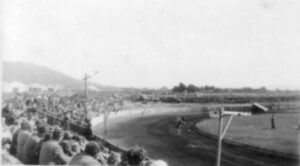
Every track must have its champion and, at the moment, Bruce Abernethy is the ruling chief. However, he has little to spare from Bill Bowe and Bowe has his followers who declare that machine for machine Bowe would beat Abernethy. That is a matter of opinion. What is most apparent, however, is that the day when a track could depend on the personality of one rider has long since gone.
The Kilbirnie Speedway was popularized by Wally Kilmister, but it was necessary to bring overseas riders across to provide him with competition. The result was that few local riders had the opportunity of improving. At the Taita Speedway a different policy has been followed. The local riders have been encouraged to improve, and they will be given that encouragement until, not one, but several will be in a class capable of meeting overseas riders. This means that the policy of building up one star at the expense of others cannot, and should not be followed. With Abernethy, Bowe, Hansard. Boyle and McMillan as a basis the Taita Speedway authorities have a “full hand.”
One or the other may have a bad night from time to time, but the others are capable, with the assistance of the other improvers, usually found in the Special Eight races (such men as Kevin Bock, Peter Dykes, Theo Underwood and Rich Tunbridge), of making for an attractive programme. A sensible system of handicapping ensures that all riders have chances of winning cash prizes in addition to the appearance money or retaining fees each rider receives. In the last two meetings only four riders out of 20 competing have not received cash prizes in addition to the appearance money. This appearance money is based on £7 for men on the scratch mark and a reduction of £1 a second according to the mark of the others. No rider receives less than £2 a week, and this comes in handy for machine maintenance.
With an electrical timing device already working most satisfactorily the Taita Speedway authorities are now introducing an electrical starting gate. This will make the Taita track one of the most up-to-date in New Zealand. Building restrictions have prevented the completion of seating and other amenities, but the track itself is considered by old-time and visiting riders to be equal to any cinder track ever put down in New Zealand.
Two of the first season stars were Bruce Abernethy (not yet 21 years old) on left, and Frank Boyle. These sketches are from Taita Speedway programmes from the first 1947/48 season.

The above mentioned Easter meetings drew crowds of between 9,000 and 10,000 and included a visiting rider from Auckland. This was Jack Hunt who at the Monday meeting took out the NZ Championship. He scored 20 points with Abernethy on 19, Bowe on 15 and Boyle on 11. Both Hunt and Abernethy fell in the final round but had enough points to edge out Bowe. Hunt had spent a season in England to gain experience and both he and Abernethy left for England a few days after Easter. (see below)
There was one final meeting before they went, on 3/04/48, and this featured a teams race series between Abernethy, Boyle, Kevin Bock and Hansard from Taita and an Auckland team of Hunt, George Mudgway, Len Perry and Merv Neil. The visitors were unlucky though as Hunt and Neil crashed and left Hunt out for the night. Those two and three other riders visited hospital that night as a result of crashes.
This is Kevin Bock who rode for Taita in the above mentioned teams event.
The meeting had been held up for 15 minutes as a crowd estimated at 12,000 turned up and the latecomers broke down the gates to get in. Frank Boyle was given a trophy that night as most improved rider for the season. This brought to a close a very successful first season.
While in England Abernathy and Hunt won the International Pairs event at Rayleigh Speedway but shortly after Hunt had a big fall and was out for the season. Abernethy returned to NZ in November but Taita had already run two meetings. Later in the season Jack Hunt became manager at Taita.
Back at Taita the opening meeting on 23rd of October 1948 featured an Australian Les Moore. For the new season feature race prize money was up to £45 so competition was fierce. In front of a crowd of 6000 who had paid 2/6 each to get in, Frank Boyle and brother Don were the big guns with other riders including Peter Dykes, “Ecles” Langford, Rich Tunbridge and Trevor Redman from Christchurch.
The second meeting saw Tunbridge star along with another newcomer named Vern de Joux. Sid Jensen from Palmerston North was the main winner in the third meeting on 8th November. There was excitement for the crowd when Tom Partridges machine burst into flames on the start line but a fast lap of the track put the flames out! To satisfy council rulings that the stadium must be used for other sports as well (even in those days there were “administrative problems”) the club staged a softball game and marching girls before the meeting started. Also at that meeting newcomer Mal Ruddleston rode his new £310 JAP bike imported from UK.
For the next meeting on 23/11/48, 10,000 people turned up because–Abernethy had returned. Prior to the racing he told the crowd that he had enjoyed racing in England and although humbled by the Wembley crowds of 65,000, he was very impressed by the Wembley Supporters club with 53,000 members!!
The crowd were well rewarded because they saw Abernethy win his first race from 110 yards behind and two more from even longer handicaps.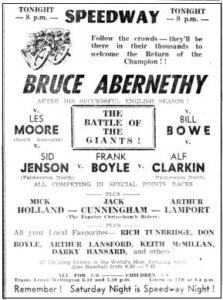
From the newspaper 20/11/48
Speedway Motor Explodes; Fans Pay For New One.
Typical of file enthusiasm speedway supporters at the Taita Track, Lower Hutt, is what occurred on Saturday night. During a race, the cylinder of Frank Boyle’s machine exploded, sending pieces of metal far and wide.
That little explosion blew about £167 worth of motor, said announcer. A few minutes later it was announced that the spectators at the pit end of the track asked that a bucket be placed at the exit so that they could make donations towards a new motor for Boyle.
Hardly had that announcement been made, when a spectator walked up to the announcer and handed over a hatful of money collected from those in his vicinity. A kerosene tin, cut half as a bucket, was more than half filled by patrons leaving track, notes being there as well as silver. Frank Boyle will have new motor, thanks to the enthusiasm of those who appreciated his fine riding and sportsmanship.
In all £127-7-2 was collected and Boyle purchased a spare motor from Abernethy ready for the next meeting and also took over a spare bike that had been used by Split Waterman to place 4th in the Wembley World Final.
Around this time a meeting between officials of Taita and Palmerston North tracks decided to start teams racing and this spread to include Auckland and later Christchurch.
These two photo’s are of teams at Taita in February 1949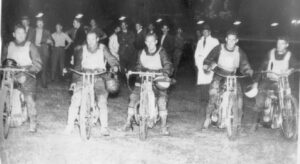
The photo at left shows the Palmerston North team of Mal Craven, Gil Craven, Alf Clarken, Bob Wigg and Peter Pollett.
Below is the Hutt team for Taita. Bill Bowe, Rick Tunbridge, Kevin Bock, Bruce Abernethy and Frank Boyle.
The Taita track was generally known as the best track in NZ at the time for solo bike racing. It had longish straights and tight corners and had a cinder surface. Palmerston North was more oval and was a clay surface so riders had some problems adapting to each track.
Auckland sent a team to Taita 20th of December 1948 and it included Harold Fairhurst who was a Huntly coal miner and had spent a season riding for Ian Hoskins in the Glasgow Tigers team. Other members included George Mudgeway, Ron Seed and Danny Calder. The evening ended with a 26/22 win to Hutt. Best race of the night was a match race between, Abernethy, Mudgeway, Fairhurst and Boyd which saw Abernethy hold the inside line for the 4 laps which forced Fairhurst to try unsuccessfully around the outside and resulted in a new record 4 lap record of 82 and 2-5 th sec.
The meeting on 28th of December was the first anniversary for the track and featured Kevin Hayden and new rider George “Spud” Murphy compete in the Junior grade races. The Jan 15th meeting saw the Palmerston North sensation Gil Craven turn out to try and beat Abernethy. Craven had raced in UK and Australia and was 1947 NZ champion. He also held the 4 lap clutch start record at Palmerston North in 75 and 2-5 sec. The meeting was held in showery weather and the big four series saw Abernethy win the first with Craven in the second but the third race Abernethy went inside Craven and they both fell with Abernethy being disqualified for “dangerous riding”. The fourth race was not run as Craven did not want to ride unless Abernethy did, so they cancelled it!
Around this time the popularity of bike speedway was such that Christchurch and Masterton were also building tracks.
The next teams race was on 22nd of Jan and 15,000 jammed the track surrounds, (with several thousand more turned away), to watch the racing for the Golden Helmet trophy shown below. This trophy was given by Uniweld in Christchurch for interclub competition.
This trophy was given by Uniweld in Christchurch for interclub competition.
For Palmerston North this time Gil Craven from England was joined by brother Malcolm and the night finished with a 24/24 draw. Craven (Gil) and Chukka Abernethy shared most of the wins that night. Abernethy gained the name “Chukka” because he worked in a men’s clothing factory that used the trade name Chukka.
Peter Pollett visited for the next meeting on 25th of Jan and mastered the cinders to become that nights star.
 This team shot from January 16th.1950 shows from left; Charlie Spinks, Frank Boyle, Peter Dykes, Dick Lawton (team mechanic) Bruce Abernethy and Kevin Hayden for Hutt.
This team shot from January 16th.1950 shows from left; Charlie Spinks, Frank Boyle, Peter Dykes, Dick Lawton (team mechanic) Bruce Abernethy and Kevin Hayden for Hutt.
For Christchurch, Mick Holland, Norm Parker, Trevor Redman, Dick “Wall of death” Campbell, 18 year old Craig “Spike” Jones and Alison Holland who was the Christchurch co-promoter with Des Wild. Christchurch won 31 to 17.
Photo on right is Kevin Bock on left with brother Errol Bock standing and the mechanic with his head down is Ash Wilson.
 On left is Arthur Ambler. The boy in the white shirt in the background behind a post is Ivan Cartmell who was later to build the Penlee track and race himself.
On left is Arthur Ambler. The boy in the white shirt in the background behind a post is Ivan Cartmell who was later to build the Penlee track and race himself.
Below right is Alf Clarken.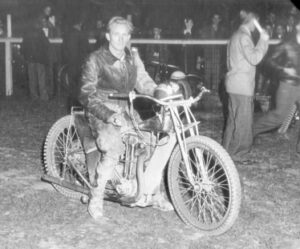
On right is newspaper photo taken at Easter 1945 “at Taita Carnival” which was possibly the show grounds where the Taita cinder track was built. It shows Bill Bowe on left and Rex Lane.
